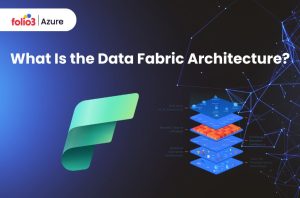Table of Contents
ToggleMicrosoft Fabric is the nucleus of all of your data requirements. It facilitates businesses and people to transform gigantic, complex data sources into practical tasks and analytics.
Therefore, Microsoft fabric security is a top priority and an absolute necessity. Securing your Microsoft Fabric implementation is vital for your data and services’ integrity, availability, and confidentiality.
With cloud environments becoming highly complex, understanding and implementing strong security techniques is essential for safeguarding your operations.
We will now discuss the best practices for Microsoft Fabric security, including Azure Service Fabric security measures, automated deployments, and strategies for creating a secure cluster.
Accelerate smart decisions with Microsoft Fabric's unified data and AI analytics.

Best Practices for Securing Your Clusters
A Service Fabric cluster refers to a set of virtual or physical machines connected through a network in which your microservices are deployed and managed.
Guaranteeing the security of your clusters is the foundation of a strong Microsoft Fabric implementation. Effective Azure Service Fabric security begins with the cluster itself, which is the basic unit of your deployment.
You can protect your environment from potential threats by conforming to Azure Service Fabric security best practices.
1. Use a Secure Cluster
One of the most important steps in implementing cluster security is making sure that your cluster is secure by design. The first step is to implement cluster security by using certificates.
Certificates help authenticate communication between nodes within the cluster and between clients and the cluster. To create a secure Service Fabric cluster, Microsoft advises using the X.509 certificates, which offer powerful encryption and authentication features.
In addition, providing client access using Microsoft Entra ID (previously known as Azure Active Directory) ensures that only authorized users can access your cluster. You can set up both admin and read-only access using the Microsoft Entra ID.
This configuration will empower you with extensive control over who can interact with your cluster. This level of control is crucial for maintaining Azure Service Fabric security, as it implements limits on access to sensitive operations.
Along with certificates and Microsoft Entra ID, another critical element is ensuring the security of all end-points. This consists of restricting access to management ports, employing strict firewall rules, and frequently updating your cluster’s operating systems and Service Fabric runtime to protect from possible loopholes and vulnerabilities.
Security hardening of your cluster is not a one-time task but an ongoing process that requires a keen eye and regular checks.
2. Use Automated Deployments
Automated deployments play an essential role in maintaining Microsoft Fabric security by minimizing the risk of human error. You must use scripts to generate, deploy, and roll over the secrets linked with your clusters. These scripts can be merged with your continuous deployment pipeline, ensuring that secrets are regularly updated and securely managed.
Storing secrets in Azure Key Vault is another advisable thing. Azure Key Vault provides a safe environment for managing secrets like passwords, connection strings, and certificates.
By unifying Azure Key Vault with Microsoft Entra ID for client access, you can guarantee that only authenticated users can extract these secrets. Needing authentication for human access to the secrets adds an additional layer of security, reducing the chances of unauthorized access.
Automated deployments also help comply with security standards, ensuring that every deployment follows uniform security protocols. This uniformity minimizes the risk of configuration drift when environments deviate from the intended security over time.
By automating the deployment and management of your clusters, you build a reliable and secure fabric that can scale quickly without risking security.
3. Create Perimeter Networks
Creating perimeter networks, also known as demilitarized zones (DMZs) or screened subnets, is a vital security practice for safeguarding your clusters from external threats.
By using Azure Network Security Groups (NSGs), you can create and implement network security rules that limit traffic to and from your cluster. NSGs act as a virtual firewall, enabling you to restrict and set which ports and IP addresses can access your cluster.
Perimeter networks protect your Microsoft Fabric implementation from attacks that target the network layer. By isolating your cluster within a DMZ, you minimize the attack areas and make it daunting for attackers to touch your sensitive resources.
Besides using NSGs, you can boost the security of your perimeter networks by administering additional security measures, such as Web Application Firewalls (WAFs) and Distributed Denial of Service (DDoS) protection.
These tools enable you to protect your applications from web-based threats and large-scale attacks that target disrupting service availability. Reviewing and updating your network security settings also ensures that your safety measures remain strong against new threats.
4. Access Cluster Virtual Machines (VMs)
Another critical aspect of Microsoft Fabric security is securely accessing cluster virtual machines (VMs). To manage your cluster or access VMs, it is recommended that you use jump servers with Remote Desktop Connection.
Jump servers, also known as bastion hosts, act as an intermediary between the user and the cluster, providing a secure method to manage your connection.
Using jump servers lowers the chance of your virtual machines (VMs) being unmasked to the Internet, a frequent source of attack. By routing all management traffic through a jump server, you can implement rigid access controls, further enhancing your Azure Service Fabric Security.
In addition, utilizing Just-in-Time (JIT) VM access, which is available through Azure Security Center, can provide additional security. JIT access ensures that management ports on your VMs are only open when required and are automatically closed afterward.
This minimizes the opportunity for attackers to exploit open ports, making it challenging for unauthorized users to gain access.
Implementing Cluster Security by Using Various Technologies
Implementing secure clusters needs a heterogeneous strategy, employing various technologies to protect the different elements of your Microsoft Fabric implementation. Understanding node-to-node security, client-to-node security, and Service Fabric Role-Based Access Control (RBAC) is mandatory for an all-encompassing security strategy.
1. Node-To-Node Security
Node-to-node security ensures that communication between the nodes in your cluster is encrypted and authenticated. This is critical for preventing man-in-the-middle attacks, where an attacker intercepts and possibly alters the data that is being transmitted between nodes. ·
Microsoft Fabric security practices for implementing secure clusters include encrypting all communication within the cluster using Transport Layer Security (TLS).
Along with TLS, setting up each node with individual certificates ensures that only authorized nodes can join the cluster. This certificate-based authentication prevents unauthorized systems from joining your cluster, which could otherwise jeopardize the entire environment.
Regularly rotating these certificates further strengthens node-to-node security by minimizing the risk of any single certificate being leaked.
2. Client-To-Node Security
Client-to-node security aims to secure interactions between external clients and your cluster nodes. Implementing cluster security for client-to-node communication comprises authenticating clients using certificates or Microsoft Entra ID and encrypting the data during transmission.
This ensures that only authorized clients can communicate with your cluster and that the data exchanged is protected from eavesdropping.
However, using multi-factor authentication (MFA) for client access adds a layer of security, making it almost impossible for unauthorized users to gain access even if they get a valid credential.
By integrating encryption, authentication, and MFA, you create a robust and solid security framework that protects the integrity and confidentiality of your communications.
3. Service Fabric Role-Based Access Control (Service Fabric RBAC)
Service Fabric Role-Based Access Control (RBAC) is a powerful tool for managing access to your cluster. With Service Fabric RBAC, you can set specific roles for users and applications so they are limited to their needed resources.
This minimizes the possible damage from a compromised account, as the attacker would only have access to a limited set of operations.
Implementing a principle of least privilege (PoLP) via RBAC ensures that users and applications only have the required permissions for their roles. This strategy reduces the attack surface and restricts the possible impact of any security breaches.
Regular checks of RBAC configurations help ensure that roles are always scoped and that access is only granted where it is genuinely needed.
Secure Service Fabric Cluster by Using Azure Resource Manager Templates
Using Azure Resource Manager templates is a simplified and reusable method for creating and managing your Microsoft Fabric implementation. These templates enable you to define your cluster configuration as code, making it easy to implement security best practices consistently across all your deployments.
1. Use the Azure Resource Manager Template
To create a secure Service Fabric cluster, use an Azure Resource Manager template with all the necessary security configurations. These templates can define everything from the virtual network and NSGs to the certificates and secrets used for securing your cluster.
Using a template ensures that your cluster is always installed with the same security settings, reducing the risk of misconfigurations.
Moreover, Azure Resource Manager templates empower you to implement automated compliance checks as part of the deployment process. This guarantees that your clusters are deployed securely and conform to your organization’s security regulations.
Integrating these checks into your deployment pipeline allows you to catch potential security issues before they affect your production environment.
2. Treat Your Cluster Configuration as Code
Treating your cluster configuration as code (CaC) is a benchmark for maintaining Microsoft Fabric security. By managing your cluster configuration in a version-controlled repository, you can monitor changes over time, roll back to previous configurations, and deploy code reviews to detect possible security issues before they escalate.
Configuration as code also lets you automate the deployment of your clusters, ensuring that they are permanently configured following your security policies. This approach is highly beneficial when managing multiple clusters in different environments, enabling you to apply the same security standards.
CaC also helps in disaster recovery and incident response, as you can quickly redeploy a cluster in a secure state. With a well-documented and version-controlled configuration, your team can efficiently respond to security issues, minimizing downtime and damage.
Conclusion
Securing and safeguarding your Microsoft Fabric implementation is a complex and layered process that demands implementing best practices in multiple deployment elements.
By focusing on Azure Service Fabric security, including securing your clusters, automating deployments, and using Azure Resource Manager templates, you can create a solid and secure environment. These practices for implementing secure clusters protect your data and applications from threats and guarantee compliance with industry standards.
Always remember that security is an ongoing process. Regularly review and upgrade your security practices to safeguard your clusters from new dangers. By prioritizing security as an integral part of your Microsoft Fabric implementation, you can protect your organization’s assets, maintain customer trust, and ensure the long-term success of your cloud operations.
If you want to augment the security of your Microsoft Fabric implementation, consider utilizing Azure’s extensive suite of security tools and services. These tools can help you implement the Azure Service Fabric security best practices discussed in this blog, ensuring your environment remains secure and resilient.
For more detailed guidance and to explore further, visit Azure’s security solutions.




